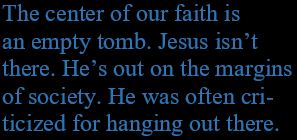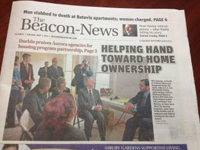 I knew that if I preached long enough I would either have Matthew 6:25-34—or parallel passages in Mark and Luke—assigned to me if I spoke on a Sunday that these passages were the Lectionary readings. Or I would just choose them myself to get over the waiting. Thus, the Video below: a sermon where I actually chose to speak on the passage, at least the Lilies of the Field part. The passage is from Jesus’ Sermon on the Mount and uses birds and lilies to illustrate why we shouldn’t worry. They have bothered me for a long, long time. Similarly, the song “Ebony and Ivory” has irritated me ever since Paul McCartney and Michael Jackson decided to get together and write some hits, and sure enough “Ebony and Ivory” became one. It spent seven weeks—SEVEN!—atop the Hot 100 chart in the U.S., becoming McCartney’s longest, post-Beatles chart topper. I hate that song, as do many others.
I knew that if I preached long enough I would either have Matthew 6:25-34—or parallel passages in Mark and Luke—assigned to me if I spoke on a Sunday that these passages were the Lectionary readings. Or I would just choose them myself to get over the waiting. Thus, the Video below: a sermon where I actually chose to speak on the passage, at least the Lilies of the Field part. The passage is from Jesus’ Sermon on the Mount and uses birds and lilies to illustrate why we shouldn’t worry. They have bothered me for a long, long time. Similarly, the song “Ebony and Ivory” has irritated me ever since Paul McCartney and Michael Jackson decided to get together and write some hits, and sure enough “Ebony and Ivory” became one. It spent seven weeks—SEVEN!—atop the Hot 100 chart in the U.S., becoming McCartney’s longest, post-Beatles chart topper. I hate that song, as do many others.
On March 26, 2022, Sam Kemp wrote this for the UK’s Far Out magazine: “There’s a reason the comments section is turned off on the ‘Ebony and Ivory’ Youtube page. The 1982 duet between Paul McCartney and Stevie Wonder is undoubtedly one of the most hated pieces of music ever to emerge from a recording studio, ranking just below Mr Blobby’s 1993 Christmas Number One, ‘Mr Blobby’ in terms of its capability to make you want to eat your own ears. It was loathed at the time and, 40 years later, I don’t see much reason for that disdain to let up: ‘Ebony and Ivory’ isn’t just painfully dull on a  musical level, its whole message is also dangerously reductive.” It reduces the problem of racism to a stupid metaphor: black and white keys get along harmoniously on a piano keyboard, so why can’t we. It’s a simple-minded, insulting take on what Rodney King said with great passion and tragic sadness: “Can’t we all just get along?” The simple answer is that we humans can’t get along like black and white piano keys because—well, we’re not piano keys. That the song was so popular is another indication of how much Americans wish racism was something so simple they wouldn’t have to think about it at all.
musical level, its whole message is also dangerously reductive.” It reduces the problem of racism to a stupid metaphor: black and white keys get along harmoniously on a piano keyboard, so why can’t we. It’s a simple-minded, insulting take on what Rodney King said with great passion and tragic sadness: “Can’t we all just get along?” The simple answer is that we humans can’t get along like black and white piano keys because—well, we’re not piano keys. That the song was so popular is another indication of how much Americans wish racism was something so simple they wouldn’t have to think about it at all.
While I don’t hate the Lilies of the Field passage as much as “Ebony and Ivory,” I have roughly the same reaction to Jesus’ injunction not to worry because, well, lilies don’t worry about what to wear and look how beautiful they are. Yeah, but they’re flowers. Humans are not. Usually I give a fairly detailed summary of sermon videos. This time I’m just inviting you to watch it. It’s not, in my opinion, an altogether convincing defense of this passage, partly because I still am bothered, sometimes irritated, by it. But I feel bound to try to take everything Jesus said seriously, and of course worrying is one of the things that does ruin so much of the peace we could have had if only we could stop worrying so much. I’ll only say that the main idea is be rooted, like a flower is rooted. But here the “soil” I speak of is trying to be rooted in the present, and trying to be rooted in God’s love and grace.
It’s important to note, too, that I begin by talking about Martin Luther King Jr’s so-called “Riverside Sermon.” It was, I believe, his greatest sermon, given during the height of the Vietnam War. Worrying too much also generates tremendous fear, and what struck me about MLK Jr’s sermon is not only its fearlessness, but also this circumstance. One year to the day he first gave this sermon, he would die at an assassin’s hand. The night before that he gave his “Mountain Top” sermon. It was as if he knew he didn’t have long to live. “Tonight I’m not worried about anything,” he said, “I’m not fearing any man.” Though he and the crowd were absolutely charged with emotion, there was a peace there, too, one that passed all understanding. He was rooted…almost like a flower.
♦ Go HERE for a complete list of sermons, like “Pentecost Means No ‘Supremacies,’” “Sacred Doing,” and “Theology and Race.”









Whales, and An Ethic for the Age of AI
The graphic for Addrienne LaFrance’s Atlantic article.
Below is a 3:48 highlights VIDEO of a recent trip my wife and I took to Cabo San Lucas, specifically to watch whales. We were not disappointed. But aside from the Video, this commentary isn’t really about whales. It’s my take on Adrienne LaFrance’s article in the July/August 2023 Atlantic titled “In Defense of Humanity.” As the subheading says, “We need a cultural and philosophical movement to meet the rise of artificial superintelligence.” It’s more nuanced and sophisticated than my summary, so I’d urge you to read it for yourself. It’s not long. It amounts to four points from which a possible ethics for the age of AI could arise. Whales are an illustration of Point Four below.
1. TRANSPARENCY: If you’ve used AI to create anything, just tell us you did. Writers like Ayad Akhtar, who won a 2013 Pulitzer for his play Disgraced, are already openly making AI a part of their writing process, as are many visual artists. As a former writing professor, I would just ask students if they used AI and have them describe their process of using it at the end of their papers. A law or an ethic of transparency would do much to warn consumers about AI-generated pictures purporting to be of someone doing this or that, including posing naked. Short of banning such pictures or hunting down and prosecuting each offender—which would be the best solution, of course—a statement saying something like “AI was used to generate this image,” or “this sound,” would give consumers important information and afford victims some semblance of protection from the beginning. This point is related to Point Three below.
2. PERSONAL CONNECTION: How convenient to meet on Zoom. Yet this should not take away from meeting in person, face-to-face. Live, personal contact should be seen as a necessity. This point is related to Point Four below.
3. PRIVACY: LeFrance says, “privacy is the key to preserving our humanity.” On a personal level, this means learning that you don’t have to share everything you’ve ever done or thought. This calls for a measure of modesty, a growing sense of your inner vs. public self, and for a careful drawing of lines that will protect you and those closest to you from outside intrusion.
4. PERSONAL WITNESSING: Whenever possible, go see things for yourself and through your own eyes. Do not rely on a virtual reality tour of Rome, but go there yourself. Which brings me back to the Video below. How long I’ve wanted to actually see whales in the wild. I watched films, including one of my oldest son’s family going whale watching in kayaks and having a humpback surface no more than 10 feet from them. So during one of the coldest days in 2025’s Chicagoland winter, we were able to fly off to Cabo San Lucas and experience what the Video below shows. What a privilege. And how privileged was I. Not everyone can do that, or actually step onto Vatican Square in Rome, as I was also able to do many years ago, but the more you can see with, and through, your own eyes, with no intervening technology, the better. Actually see your neighborhood, your backyard, the people closest to you, and even those who are strangers.